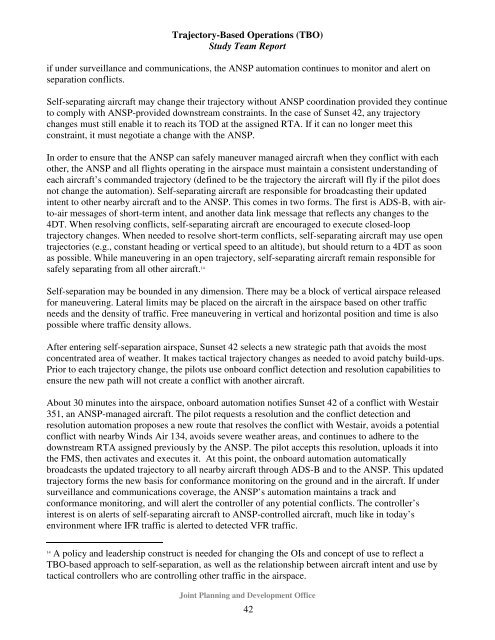Trajectory-Based Operations (TBO) - Joint Planning and ...
Trajectory-Based Operations (TBO) - Joint Planning and ...
Trajectory-Based Operations (TBO) - Joint Planning and ...
Create successful ePaper yourself
Turn your PDF publications into a flip-book with our unique Google optimized e-Paper software.
<strong>Trajectory</strong>-<strong>Based</strong> <strong>Operations</strong> (<strong>TBO</strong>)<br />
Study Team Report<br />
if under surveillance <strong>and</strong> communications, the ANSP automation continues to monitor <strong>and</strong> alert on<br />
separation conflicts.<br />
Self-separating aircraft may change their trajectory without ANSP coordination provided they continue<br />
to comply with ANSP-provided downstream constraints. In the case of Sunset 42, any trajectory<br />
changes must still enable it to reach its TOD at the assigned RTA. If it can no longer meet this<br />
constraint, it must negotiate a change with the ANSP.<br />
In order to ensure that the ANSP can safely maneuver managed aircraft when they conflict with each<br />
other, the ANSP <strong>and</strong> all flights operating in the airspace must maintain a consistent underst<strong>and</strong>ing of<br />
each aircraft’s comm<strong>and</strong>ed trajectory (defined to be the trajectory the aircraft will fly if the pilot does<br />
not change the automation). Self-separating aircraft are responsible for broadcasting their updated<br />
intent to other nearby aircraft <strong>and</strong> to the ANSP. This comes in two forms. The first is ADS-B, with airto-air<br />
messages of short-term intent, <strong>and</strong> another data link message that reflects any changes to the<br />
4DT. When resolving conflicts, self-separating aircraft are encouraged to execute closed-loop<br />
trajectory changes. When needed to resolve short-term conflicts, self-separating aircraft may use open<br />
trajectories (e.g., constant heading or vertical speed to an altitude), but should return to a 4DT as soon<br />
as possible. While maneuvering in an open trajectory, self-separating aircraft remain responsible for<br />
safely separating from all other aircraft. 14<br />
Self-separation may be bounded in any dimension. There may be a block of vertical airspace released<br />
for maneuvering. Lateral limits may be placed on the aircraft in the airspace based on other traffic<br />
needs <strong>and</strong> the density of traffic. Free maneuvering in vertical <strong>and</strong> horizontal position <strong>and</strong> time is also<br />
possible where traffic density allows.<br />
After entering self-separation airspace, Sunset 42 selects a new strategic path that avoids the most<br />
concentrated area of weather. It makes tactical trajectory changes as needed to avoid patchy build-ups.<br />
Prior to each trajectory change, the pilots use onboard conflict detection <strong>and</strong> resolution capabilities to<br />
ensure the new path will not create a conflict with another aircraft.<br />
About 30 minutes into the airspace, onboard automation notifies Sunset 42 of a conflict with Westair<br />
351, an ANSP-managed aircraft. The pilot requests a resolution <strong>and</strong> the conflict detection <strong>and</strong><br />
resolution automation proposes a new route that resolves the conflict with Westair, avoids a potential<br />
conflict with nearby Winds Air 134, avoids severe weather areas, <strong>and</strong> continues to adhere to the<br />
downstream RTA assigned previously by the ANSP. The pilot accepts this resolution, uploads it into<br />
the FMS, then activates <strong>and</strong> executes it. At this point, the onboard automation automatically<br />
broadcasts the updated trajectory to all nearby aircraft through ADS-B <strong>and</strong> to the ANSP. This updated<br />
trajectory forms the new basis for conformance monitoring on the ground <strong>and</strong> in the aircraft. If under<br />
surveillance <strong>and</strong> communications coverage, the ANSP’s automation maintains a track <strong>and</strong><br />
conformance monitoring, <strong>and</strong> will alert the controller of any potential conflicts. The controller’s<br />
interest is on alerts of self-separating aircraft to ANSP-controlled aircraft, much like in today’s<br />
environment where IFR traffic is alerted to detected VFR traffic.<br />
14<br />
A policy <strong>and</strong> leadership construct is needed for changing the OIs <strong>and</strong> concept of use to reflect a<br />
<strong>TBO</strong>-based approach to self-separation, as well as the relationship between aircraft intent <strong>and</strong> use by<br />
tactical controllers who are controlling other traffic in the airspace.<br />
<strong>Joint</strong> <strong>Planning</strong> <strong>and</strong> Development Office<br />
42
















